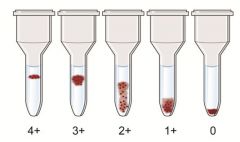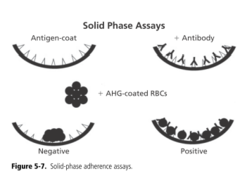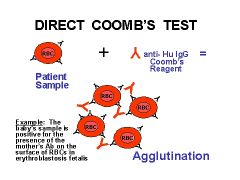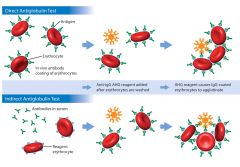![]()
![]()
![]()
Use LEFT and RIGHT arrow keys to navigate between flashcards;
Use UP and DOWN arrow keys to flip the card;
H to show hint;
A reads text to speech;
10 Cards in this Set
- Front
- Back
|
Agglutination |
1) Clumping of red cells due to antibody coating 2) Main reaction we look for in blood banking |
|
|
Two stages of Agglutination |
1) Coating of cells ("sensitization") -Substances like LISS and PEG help overcome physical barriers to allow antigens and antibodies get closer to each other 2) Formation of bridges -Lattice-like structure formation -IgG isn't good at this; IgM antibodies are better both at bridge formation and fixing complement = hemolysis
|
|
|
Tube Testing 1) Immediate spin "phase" 2) 37 degree C "phase" 3) Indirect antiglobulin "phase" |
1) Serum + 2-5% RBC together in tube, centrifuge and examine 2) Above mixture + incubate, then centrifuge and examine -Often use potentiator (LISS/PEG) 3) Wash above mixture to remove UNBOUND globulins. Then add antihuman globulin, centrifuge and examine |
|

Gel Testing (Column Agglutination) |
1) Multiple microtubules filled with gel + anti-IgG reagent 2) Gel particles separate red cell clusters by size 3) Anti-IgG grabs onto red cells coated by IgG 4) Bigger red cell agglutinates will be stuck higher in gel 5) Negative gel tests show cells in a button at the bottom while positive tests have cells spread in varying degrees through the microtube |
|

Solid-Phase Red Cell Adherence Testing |
1) Uses binding of Ab to RBCs that are themselves bound to the sides of microwells (manufacturer-created with Ag we are interested in) 2) Lab adds pt serum, incubates, washes; Ab if present binds to test RBCs 3) Indicator RBCs (coated with monoclonal anti-IgG) attach to test RBCs via bound Ab 4) Negative results - cells in a button at bottom because indicator cells don't bind to the test RBCs - no serum Ab in pt 5) Positive results - cells spread in a "carpet" because indicator cells have bound to test RBCs all along via the bound pt serum Ab |
|
|
Direct Antiglobulin Test ("Coomb's Test")
|

Red cells taken directly from pt, washed, then mixed with AHG; checks for in-vivo coating of RBCs with Ab and/or complement |
|
|
Indirect Antiglobulin Test (IAT) |

Indirect - checks for in-vitro coating of RBCs with Ab or complement |
|
|
IAT Variation |
1) Can be used to check for an unknown Ab by using RBCs with a known Ag profile - Ab screen 2) Can be used to check for an unknown red cell Ag by using serum with a known Ab specificity - RBC Ag testing 3) Can be used to check for a reacting known Ag and unknown Ab - crossmatch procedure |
|
|
Coomb's Control |
1) Used after negative DAT or IAT to ensure proper functioning of AHG reagent 2) IgG-coated RBCs added to AHG-cell mixture 3) Agglutination should occur, if negative = bad AHG or no AHG added |
|
|
Blood Groups showing Dosage |
Kidd Duffy Rh MNS
1) Certain Abs do not react as strongly with RBCs that have Ag coded for by a single gene (heterozygous) |

